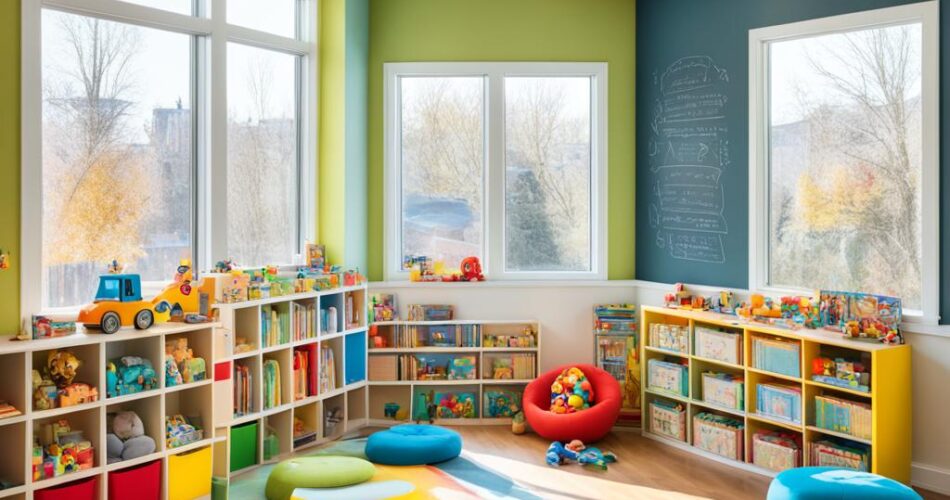Creating a perfect playroom is an exciting adventure. We’ll explore 13 fresh ideas to spark imagination and foster learning. Interior designer Raili Clasen from Newport Beach, California, shares expert tips for magical play spaces.
Imagine vibrant murals, colorful art, and eye-catching furniture bringing life to your playroom. These elements create a fun learning environment that grows with your child. Smart storage solutions like cabinets and baskets keep toys organized.
Plush rugs and comfy chairs invite kids to snuggle up with books. If space is limited, focus on specific zones like an art corner. A well-organized playroom helps kids plan and carry out their ideas.
This setup leads to longer, more engaging play sessions. It also teaches children valuable tidying skills as they grow.
Key Takeaways
- Playroom ideas offer inspiration for creative play spaces
- Colorful art and furniture create a fun learning environment
- Smart storage solutions teach organization skills
- Cozy elements like plush rugs enhance comfort
- Well-organized spaces promote longer, more engaging play
- Specific zones work well for smaller playrooms
Creating a Play Space That Grows with Your Child
A playroom that evolves with your child ensures long-term enjoyment and usefulness. Focus on adaptable elements to keep the space engaging as your child grows. This approach creates a room that remains functional for years to come.
Select Adjustable Shelving and Storage
Use adjustable shelving for flexible storage in your playroom design. Wall-mounted shelves with movable brackets adapt to changing storage needs. Soft bins for toys and labeled boxes help keep things organized.
This storage method keeps the space tidy and teaches kids organizational skills. It’s a practical way to maintain order in the playroom.
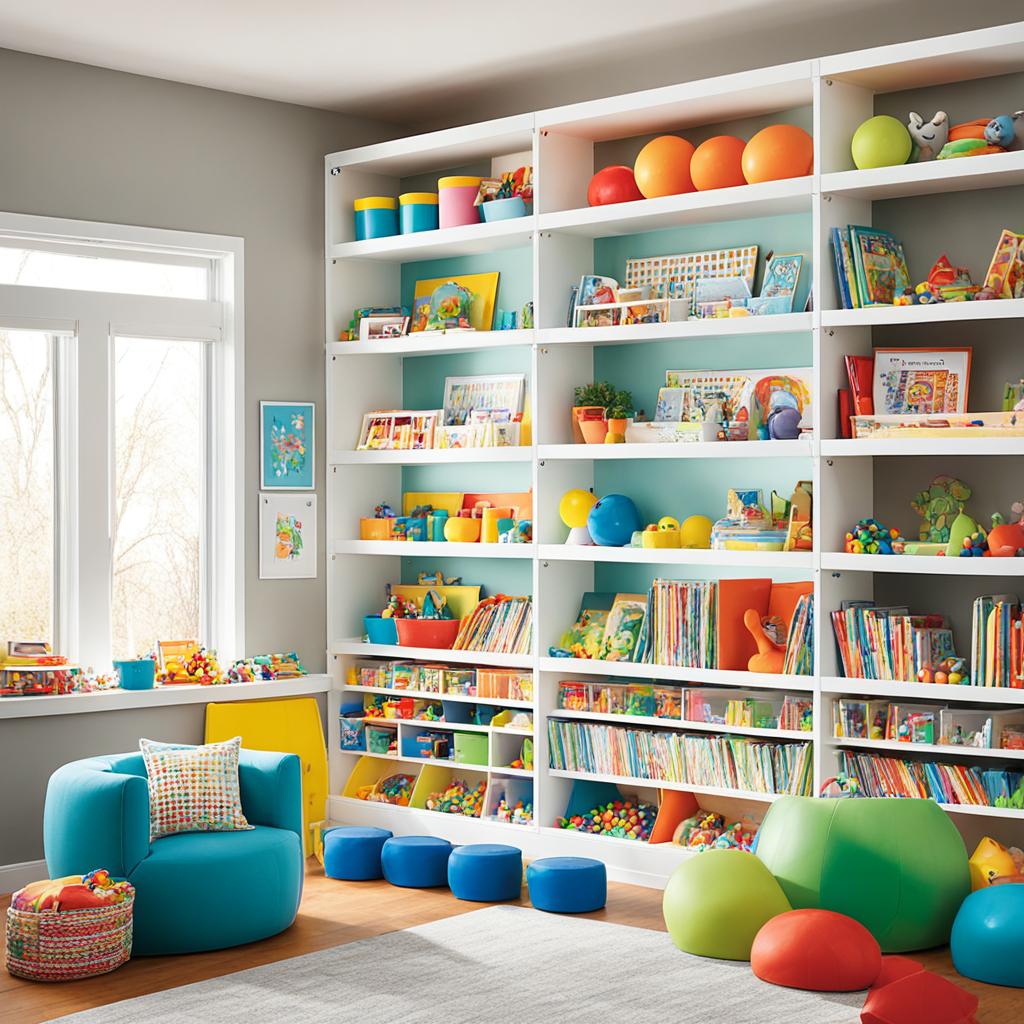
Choose Convertible Furniture Pieces
Pick convertible furniture to maximize playroom versatility. Multi-use activity tables can be craft stations, homework areas, or game tables. Storage coffee tables offer hidden spots for quick clean-ups.
These adaptable pieces support various activities. They make the most of your space as your child’s interests change.
Implement Flexible Layouts
Design a playroom with flexible layouts to suit changing interests. Use area rugs to create zones for reading, crafting, and active play. Add movable furniture like poufs or bean bags for easy rearrangement.
This approach allows the room to grow with your child. It supports their development at every stage, from toddler to teen.
| Age Group | Recommended Layout Features | Storage Solutions |
|---|---|---|
| Toddlers (2-3 years) | Open floor space, soft play mats | Low open shelves, toy boxes |
| Preschoolers (4-5 years) | Art corner, reading nook | Labeled bins, dress-up wardrobes |
| School-age (6-12 years) | Homework area, gaming zone | Adjustable shelving, desk organizers |
Combining these elements creates a dynamic playroom that adapts to your child’s changing needs. It fosters creativity and learning throughout their early years. Your child will love this space that grows with them.
Crafting an Imaginative Play Zone
Themed playrooms spark creativity and learning in children. They create a personal adventure land for daily discoveries. Your child’s playroom can become a world of wonder with imaginative design.
Themed Decor for Immersive Play
Ordinary rooms can become extraordinary realms. Create a jungle paradise, space odyssey, or pirate’s cove. Wall decals, themed rugs, and custom furniture bring these worlds to life.
A treehouse reading nook or rocket ship bed can transport kids to magical places. These elements make the playroom an exciting space for adventure.

Incorporate Interactive Elements
Make your playroom a hands-on learning hub. Install a chalkboard wall for artistic expression. Set up sensory bins for tactile exploration.
Add magnetic surfaces for creative play. These elements encourage problem-solving and enhance fine motor skills. They turn the playroom into an interactive space.
Design Multifunctional Areas
Craft play areas that adapt to various activities. A building block zone can double as a quiet reading corner. A dress-up area might transform into a puppet theater.
This flexibility keeps the space fresh and exciting. It supports different types of play and learning styles. Multifunctional areas grow with your child’s interests.
| Play Zone | Benefits | Activities |
|---|---|---|
| Art Station | Enhances creativity | Drawing, painting, crafting |
| Building Corner | Improves problem-solving | Lego construction, block stacking |
| Reading Nook | Boosts language skills | Storytelling, quiet reading |
| Dress-Up Area | Develops social skills | Role-playing, imaginative play |
Dynamic play spaces build a foundation for lifelong learning and imagination. They grow with your child, adapting to changing interests. These spaces foster development and create lasting memories.
Maximizing Floor Space for Active Kids
Smart playroom layouts boost floor space for active kids. Arrange furniture wisely to create open play areas. Use vertical storage to keep toys off the floor.
Wall-to-wall carpeting offers a safe, comfy surface for activities. Wood or linoleum floors resist stains well. Foam flooring is cost-effective and easy to clean.
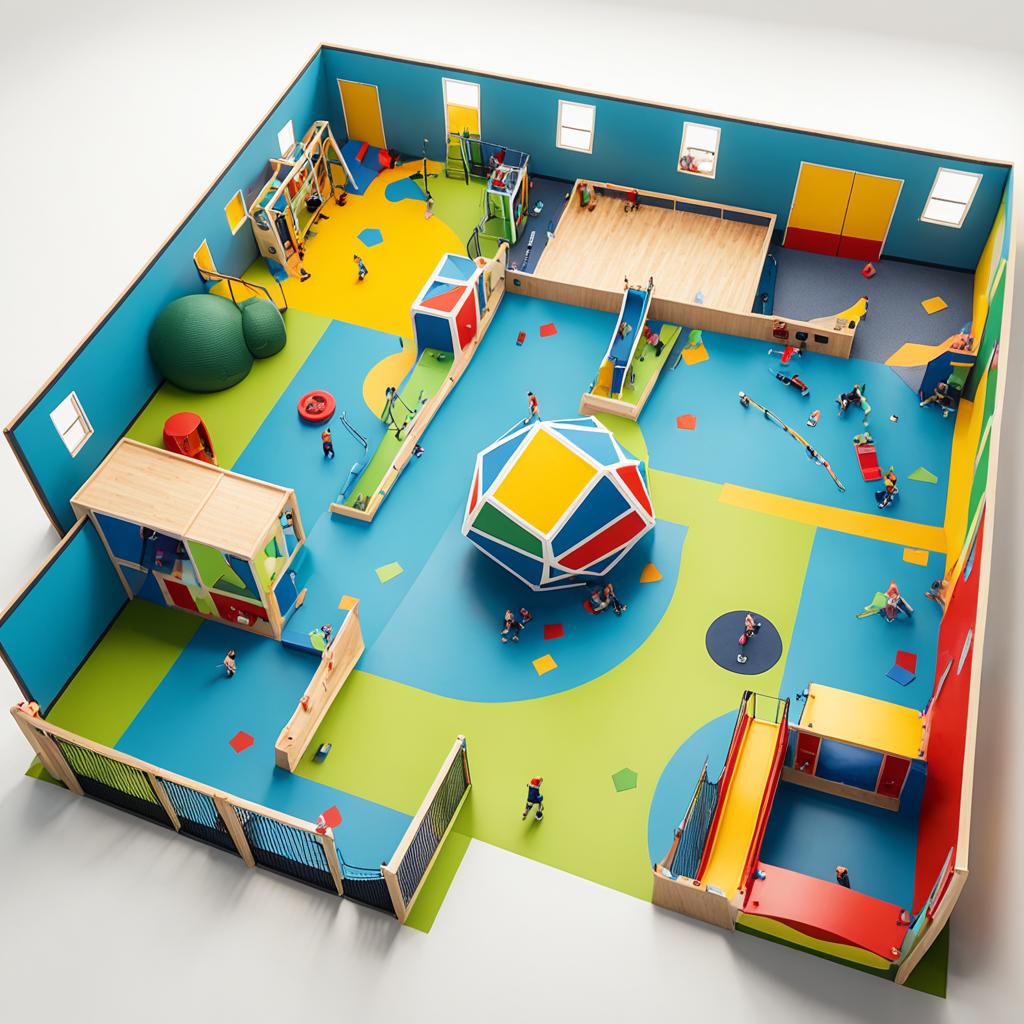
Vertical space is crucial in playroom design. Wall-mounted shelves and hanging organizers maximize floor area. Toy cubbies on walls display toys and save space.
Wicker baskets and patterned totes offer stylish storage options. Creative solutions can transform small spaces into exciting play zones:
- Building a rock wall for active climbing
- Installing a compact play kitchen
- Creating a cozy reading loft
- Adding a magnetic or chalkboard wall for interactive play
- Hanging a pod swing for indoor fun
Multipurpose furniture is key in small playrooms. Modular seating serves for sitting and play. Multi-use activity tables adapt to various games and crafts.
These clever designs help maximize floor space for active play areas.
| Playroom Feature | Percentage of Parents Using |
|---|---|
| Vertical storage solutions | 78% |
| Multipurpose furniture | 65% |
| Creative wall decor (chalkboards, decals) | 55% |
| Comfy seating options | 72% |
| Designated activity zones | 60% |
The Art of Play: Integrating Creative Stations
Creative stations turn playrooms into exciting learning hubs. Arts corners, educational spaces, and chalkboard walls spark imagination. These elements foster development and create a fun environment.
Set Up an Arts and Crafts Corner
An arts corner is key for nurturing creativity. Stock it with crayons, markers, and paper. This space encourages artistic expression and develops fine motor skills.
Colors impact a child’s creative and cognitive growth. An arts area is crucial for this reason.

Create an Educational Nook
Educational spaces are vital for cognitive growth. Set up a cozy nook with books, puzzles, and games. This area promotes learning and problem-solving skills.
Interactive stations with educational apps can boost cognitive development. They blend traditional and modern learning approaches effectively.
Install a Chalkboard Wall
Chalkboard walls offer a large canvas for creativity. They provide a fun way to practice writing, drawing, and problem-solving. This feature improves motor skills and works well for group activities.
| Creative Play Station | Benefits | Recommended Items |
|---|---|---|
| Arts and Crafts Corner | Enhances creativity, fine motor skills | Art supplies, easel, craft table |
| Educational Nook | Promotes cognitive growth, problem-solving | Books, puzzles, educational games |
| Chalkboard Wall | Improves motor skills, encourages group play | Chalk, erasers, magnetic letters |
These creative play stations form a well-rounded learning environment. They cater to various aspects of child development. Your playroom becomes a space where learning and fun blend seamlessly.
Playroom Ideas That Inspire Learning and Development
Educational playroom activities can spark discovery and fun. They transform spaces into learning hubs. Let’s explore ideas to make your playroom a powerhouse of learning.

A well-designed playroom has zones for different types of learning. Spaces like reading nooks and arts corners boost child engagement. These areas encourage exploration and skill development.
Studies show that 75% of playrooms with specific activity areas see increased child engagement. These spaces help children grow in multiple ways.
“Play is the highest form of research.” – Albert Einstein
Educational toys are crucial in these spaces. Montessori-style playrooms use natural materials to create an enriching environment. They focus on quality over quantity.
For toddlers, wooden blocks help with spatial awareness. Art supplies spark creativity in preschoolers.
| Age Group | Recommended Activities | Learning Benefits |
|---|---|---|
| Toddlers (1-3 years) | Sensory bins, pop-up toys | Tactile exploration, cause and effect |
| Preschoolers (3-5 years) | Puppet theaters, pattern blocks | Imaginative play, math concepts |
| School-age (6+ years) | Brain teasers, science experiments | Problem-solving, critical thinking |
Add interactive elements like magnetic walls or climbing features. These boost physical activity and problem-solving skills. They make learning an active, engaging process.
The goal is to blend education and play seamlessly. This approach fosters a lifelong love for learning.
Personalizing Your Child’s Playroom
A personalized playroom sparks imagination and creativity. It’s a special space for your child to explore and grow. Let’s discover ways to make their playroom uniquely theirs.
Display Children’s Artwork
Turn playroom walls into a mini art gallery. Showcase your child’s artwork to celebrate their creativity. Use colorful frames or clothespins on strings for an ever-changing display.
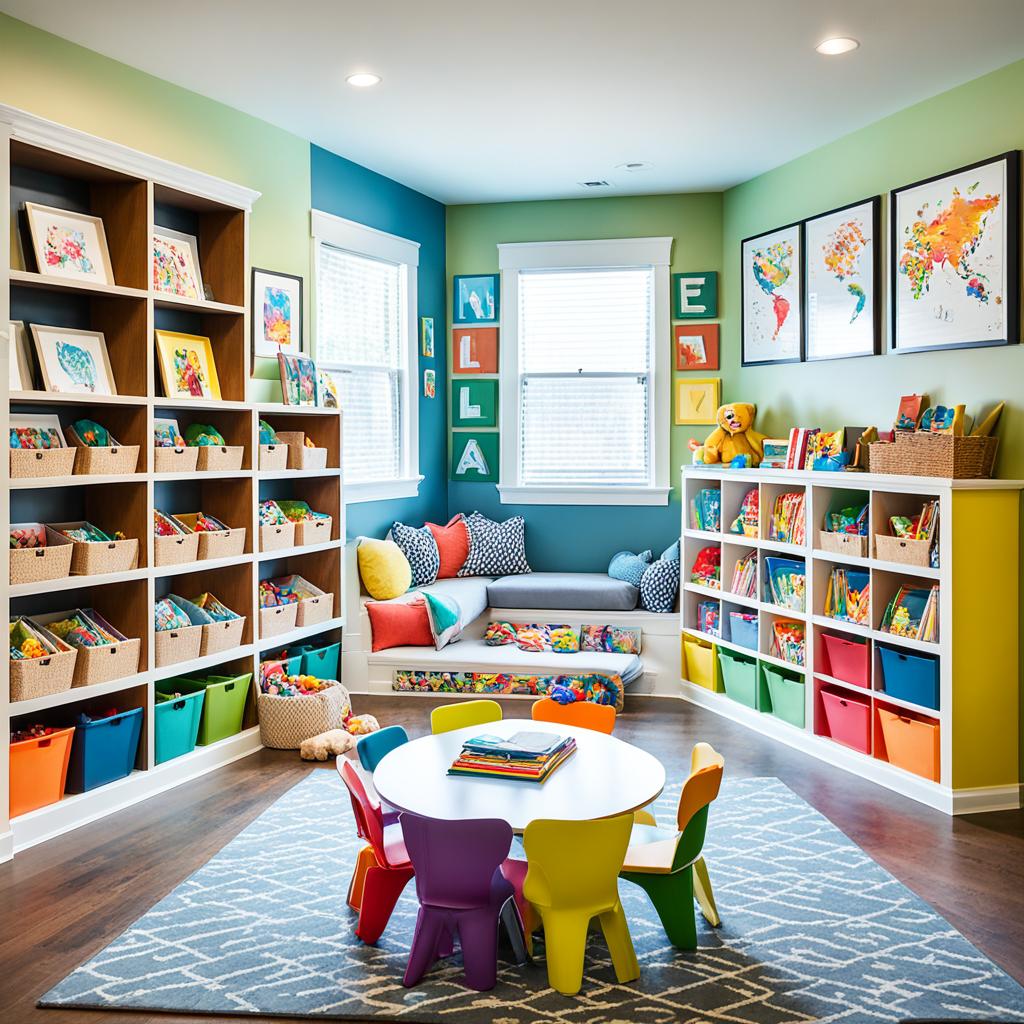
Involve Kids in Decor Choices
Let kids pick wall colors or themes for their playroom. This involvement builds decision-making skills and creates a sense of ownership. Studies show that engaging playrooms boost children’s participation levels.
Add Personal Touches and Mementos
Make the playroom feel like home with personal touches. Display family photos, cherished toys, or create a gallery wall. Stick to a color palette like aqua, red, navy, and white for a cohesive look.
- Use paper mache letters to spell out your child’s name
- Create a cozy reading nook with favorite books
- Set up a dress-up station with beloved costumes
Flexibility is key to a successful personalized playroom. Use neutral colors for larger furniture pieces. Add pops of color with easily changeable decor.
This approach allows the space to grow with your child. It ensures years of fun and learning as their interests change over time.
Functional and Stylish Storage Solutions
Smart playroom storage ideas make tidying up easier. A study found 90% of playrooms use various storage solutions for toy clutter. Let’s explore stylish options that blend function and fashion.
Wall-mounted units are popular in 60% of playrooms. They save floor space and offer open and closed storage options. Built-in storage, like bookcases and cubbies, is featured in 40% of playrooms.
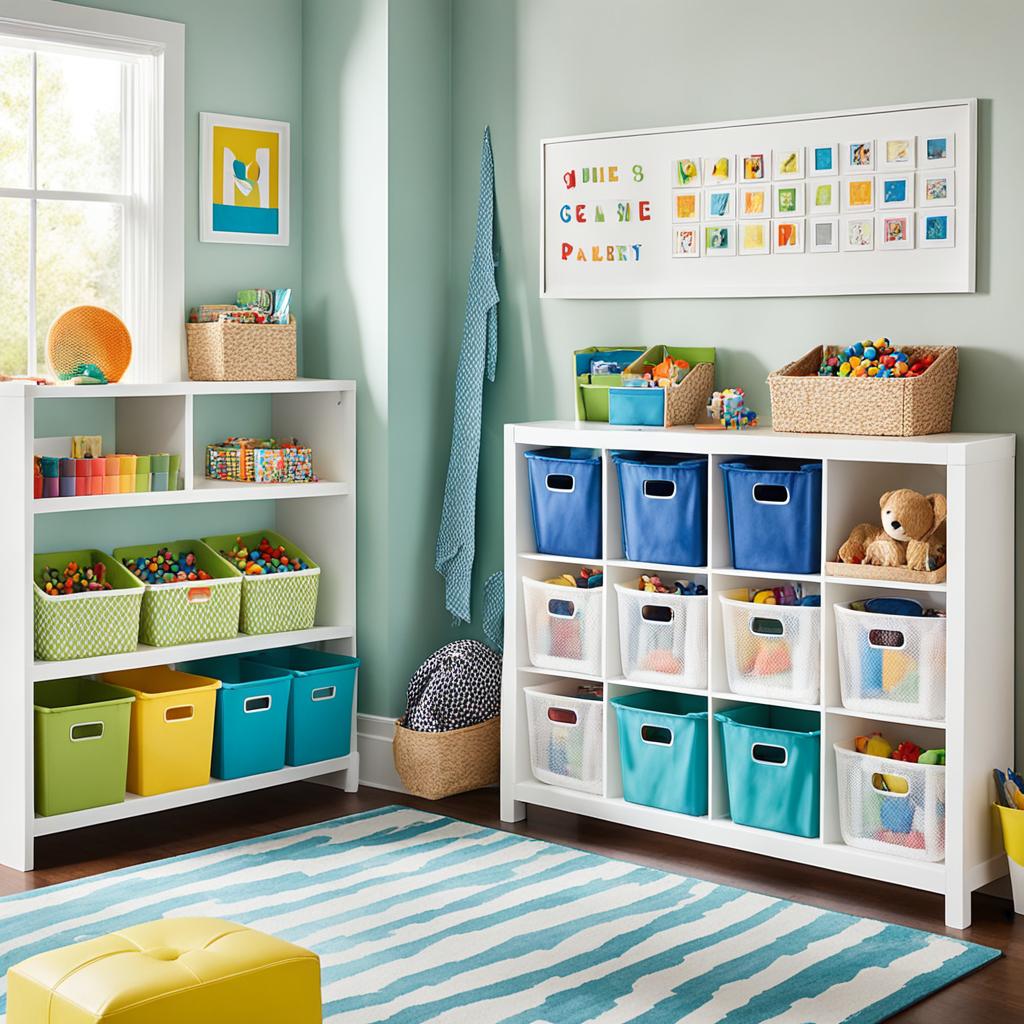
Baskets add a chic touch to 30% of playrooms. They’re great for quick cleanups and add texture. Some parents use numbered baskets instead of labels for easy organization.
Hidden storage furniture serves double duty. Benches with secret compartments or ottomans that open up offer seating and storage. These pieces are practical and stylish.
Open storage solutions are gaining popularity. Floating shelves and hanging organizers make up 10% of playroom storage. They keep toys visible and accessible for kids.
The best playroom storage ideas combine practicality with style. Mix and match solutions to create an organized and fun space. Your child’s unique needs should guide your storage choices.
Transforming Wasted Space into a Play Haven
Unused nooks can become magical playrooms for kids. These spaces spark imagination and learning. With creativity, you can create fun play areas from wasted space.
Utilize Under-Stairs Areas
Turn under-stairs space into a cozy retreat. Use leftover paint to add color without extra cost. Install adjustable cube shelving for maximum storage.
Use fabric bins to organize books, toys, and crafts. This transforms awkward areas into functional playrooms.
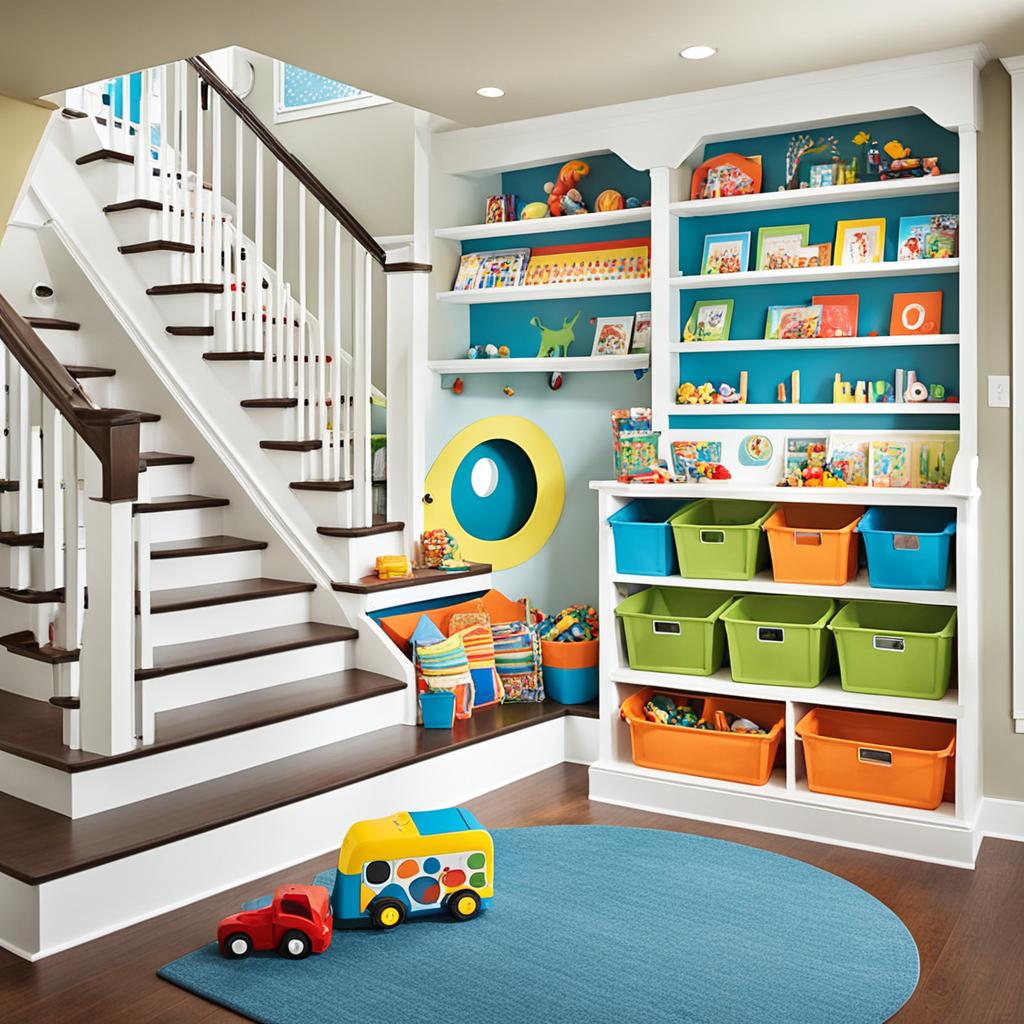
Convert Closets into Cozy Nooks
Closet play nooks offer private hideaways kids adore. Remove doors and add soft rugs, pillows, and string lights. A small table creates space for coloring or tea parties.
Install floating shelves to display favorite toys and books. This makes them easy for children to reach.
Repurpose Basement Corners
Basement play areas use often-overlooked spaces. Section off a corner with colorful curtains or room dividers. Add foam floor tiles for a soft play surface.
Bring in child-sized furniture like a craft table or reading chair. This encourages imaginative play in the repurposed space.
These clever designs create delightful play havens that grow with your child. Cozy hideaways spark creativity while keeping toys organized. You’ve maximized your home’s space for fun and learning.
Creating a Safe and Comfortable Play Environment
Designing child-friendly spaces is crucial for your little ones’ well-being and development. Start by installing bright overhead lighting to improve visibility. Secure furniture to walls and remove sharp edges to prevent injuries.
Comfortable play areas let kids explore and learn freely. Use EVA dual-color reversible foam tiles for a non-slip, cushioned floor. Organize the space into zones for reading, art, and imaginative play.
Use bins, shelves, and cubbies to keep toys organized and accessible. Rotate toys regularly to keep the space exciting. This approach helps manage energy levels and promotes balanced play.
By following these tips, you’ll create a safe playroom where children can thrive. Your kids will have fun in an engaging environment designed just for them.
